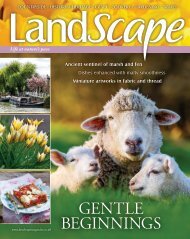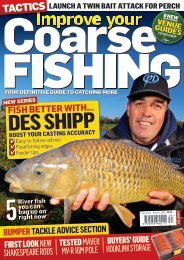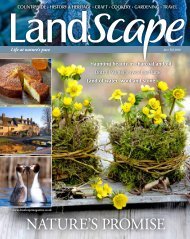Create successful ePaper yourself
Turn your PDF publications into a flip-book with our unique Google optimized e-Paper software.
TROUT & SALMON AUGUST 2017 <strong>Salmon</strong> on a single-h<strong>and</strong>er • Master the sedge hatch • Ballynahinch • Cane rods • Fish the riffling hitch • Dry-fly on Draycote www.trout<strong>and</strong>salmon.com<br />
WIN<br />
AUGUST 2017 £3.70<br />
(JUNE 29-JULY 26)<br />
CANE<br />
AND ABLE<br />
Why a modern bamboo rod will<br />
transform your stream fishing<br />
50 GAME FAIR TICKETS AND A LOOP ROD<br />
THE VOICE OF GAME-FISHING SINCE 1955<br />
MIDSUMMER<br />
MAGIC<br />
• Thrilling salmon sport on a single-h<strong>and</strong>er •<br />
•<br />
HUNTING<br />
WITH BIG RED<br />
Alternative tactics to try on<br />
Engl<strong>and</strong>'s best dry-fly reservoir<br />
NEW<br />
TACKLE<br />
VISION SCOUT WADERS<br />
RUTLAND BOAT SEAT<br />
WINSTON AIR ROD<br />
PLUS SIX SCOOP NETS<br />
Mastering the sedge hatch<br />
Tempt salmon to the surface with the riffling hitch<br />
THE<br />
FULL IRISH<br />
Grilse, whiskey <strong>and</strong> the<br />
black stuff at Ballynahinch
THE VOICE OF GAME-FISHING SINCE 1955<br />
CONTENTS AUGUST 2017<br />
COVER<br />
HIGHLIGHTS<br />
COVER IMAGE: RIVER LYON.<br />
PHOTOGRAPHY BY: PETER GATHERCOLE.<br />
8<br />
14<br />
37<br />
47<br />
56<br />
Hunting with the Big Red<br />
Boatcraft <strong>and</strong> a deadly dry-fly<br />
help Andrew Flitcroft on Draycote<br />
H<strong>and</strong> me down my<br />
fishing cane<br />
James Beeson tries an<br />
Edward Barder split-cane rod<br />
The full Irish<br />
Whiskey, the black stuff <strong>and</strong><br />
a spate river for Toby Coe<br />
Summer’s main event<br />
25 pairs of tickets to the Game<br />
Fair to be won<br />
How to fish the hitch<br />
Graeme Simpson helps you to<br />
master a deadly surface tactic<br />
58 Sedges<br />
Paul Procter offers patterns for<br />
the sedge hatch<br />
62<br />
Catch salmon on<br />
a single-h<strong>and</strong>er<br />
A no-nonsense guide to tackle<br />
<strong>and</strong> tactics from Jim Coates<br />
85 Crossword<br />
Win a fantastic Loop Cross ST<br />
11 ft 7 wt switch rod<br />
SUBSCRIBE!<br />
Take out a subscription<br />
<strong>and</strong> receive two fantastic<br />
fly-boxes<br />
SEE PAGE 86<br />
24<br />
37<br />
FEATURES<br />
20<br />
24<br />
31<br />
32<br />
44<br />
The highs of summer<br />
Laurence Catlow’s stories of the<br />
Welsh hills <strong>and</strong> Yorkshire Dales<br />
When the east<br />
wind blows<br />
Tough conditions confront<br />
Stan Headley in the Highl<strong>and</strong>s<br />
Lucky man<br />
The tale of Ian Gordon’s monster<br />
Icel<strong>and</strong>ic brown trout<br />
Accidents will happen<br />
The course of true fishing does not<br />
run smoothly for Jon Beer<br />
Slowing the flow<br />
Mike H<strong>and</strong>yside hears alarming<br />
stories of habitat destruction<br />
14<br />
8<br />
August 2017 | 3
CONTENTS AUGUST 2017<br />
62<br />
72<br />
KNOW HOW<br />
56<br />
How to fish the hitch<br />
Graeme Simpson helps you to<br />
master a deadly surface tactic<br />
58 Sedges<br />
Paul Procter offers patterns for<br />
each stage of the sedge’s life cycle<br />
61<br />
62<br />
67<br />
68<br />
70<br />
72<br />
Casting school<br />
The art of the sustained anchor,<br />
with Eoin Fairgrieve<br />
Catch salmon on<br />
a single-h<strong>and</strong>er<br />
A no-nonsense guide to tackle<br />
<strong>and</strong> tactics from Jim Coates<br />
<strong>Trout</strong> fly of the month<br />
Rob Denson ties the M<strong>and</strong>arin<br />
Orange to match terrestrials<br />
<strong>Trout</strong> surgery<br />
Running fisheries, red letter days<br />
<strong>and</strong> double dry-fly tactics receive<br />
Ronnie Glass’s attention<br />
<strong>Salmon</strong> surgery<br />
Crawford Little responds to<br />
questions about tough conditions,<br />
leaders <strong>and</strong> long-winged flies<br />
<strong>Salmon</strong> fly of the month<br />
Every fly-box should have a Black<br />
Sheep, says Ross Macdonald<br />
TACKLE<br />
73<br />
77<br />
78<br />
79<br />
First look<br />
Vision Scout waders, the Winston<br />
Air rod <strong>and</strong> the new John Gierach<br />
book are reviewed<br />
Super scoop nets<br />
Six nets for river trout fishing<br />
Reader offer<br />
A Greys Strata Fly Vest at an<br />
excellent price<br />
Tried <strong>and</strong> tested<br />
A long look at the Stillwater<br />
Rutl<strong>and</strong> Boat Seat<br />
32<br />
114<br />
73<br />
REGULARS<br />
& NEWS<br />
7<br />
Editor’s letter<br />
Andrew Flitcroft on the<br />
AST’s new initiatives<br />
42 Newsreel<br />
The latest news <strong>and</strong> reports from<br />
the world of game-fishing<br />
46<br />
Casting about<br />
Richard Donkin considers the<br />
natural competition<br />
50 Letters<br />
Your views aired<br />
82 Property<br />
Houses with fishing for sale<br />
85 Crossword<br />
Win a fantastic Loop Cross ST<br />
11 ft 7 wt switch rod<br />
89<br />
111<br />
114<br />
xx<br />
Fishing reports<br />
News <strong>and</strong> catches from the major<br />
fisheries in the UK <strong>and</strong> Irel<strong>and</strong><br />
Fish of the month<br />
Enter to be in with a chance of<br />
some smashing Sharpe’s prizes<br />
Last cast<br />
Giles Catchpole offers some<br />
casting advice<br />
77<br />
August 2017 | 5
KNOW HOW<br />
How to<br />
GRAEME<br />
SIMPSON<br />
is an AAPGAI<br />
<strong>Salmon</strong> Master<br />
<strong>and</strong> gillie at<br />
Birse on the<br />
Aberdeenshire<br />
Dee<br />
fish the hitch<br />
Graeme Simpson helps you to master a simple<br />
but deadly surface tactic for salmon<br />
REACH FOR A FLOATER<br />
Riffle-hitching works best when the fish are<br />
on the take in the upper metre of the water<br />
column. When you are instinctively reaching<br />
for the full floating line, it’s time to fish the<br />
hitch. It’s also the first method I will try when<br />
the water is low <strong>and</strong> clear <strong>and</strong> the fish are<br />
easily spooked.<br />
AVOID WIND<br />
AND SUN<br />
Strong winds, whether<br />
upstream or down, can<br />
catch a fly-line like a sail<br />
during its swing across a<br />
pool, causing a loss of<br />
tension <strong>and</strong> making it<br />
difficult to form the<br />
essential riffle or V-wake<br />
with the surface fly.<br />
Bright days with glare<br />
are bad news. <strong>Salmon</strong> <strong>and</strong><br />
sea-trout will be less likely<br />
to attack a surface fly <strong>and</strong><br />
watching the fly can be<br />
difficult, straining your<br />
eyes even if you’re<br />
wearing sunglasses.<br />
TRY AND TRY AGAIN<br />
When a fish has shown interest, it’s important not<br />
to be hasty. Maintain the swing, keeping the fly<br />
hitching all the way to the bank, before re-casting.<br />
Then swing the fly at the same angle or adjust its<br />
speed or angle. If there’s no response, try a smaller<br />
fly – fishing it slower will create a smaller wake <strong>and</strong><br />
this often produces results.<br />
This grilse couldn’t resist the lure of a hitch tube.<br />
CHOOSE A ROD, LINE AND LEADER<br />
Put the 15-footer away. I use 9 ft-10 ft<br />
single-h<strong>and</strong>ed rods, rated six- to eightweight.<br />
A 9 ft 6 in seven-weight is ideal.<br />
A single-h<strong>and</strong>er also frees up your line<br />
h<strong>and</strong>. A light double-h<strong>and</strong>er or switch rod<br />
can be used if fishing at greater distance<br />
<strong>and</strong> the extra reach can be beneficial.<br />
Use a fly-line with a short head because<br />
you may h<strong>and</strong>-line (retrieve) all the way<br />
around the swing <strong>and</strong> need to re-deliver<br />
the fly with minimal false casts or pop it<br />
straight back out with a spey cast. Avoid<br />
heavy lines, which cause unwanted<br />
surface disturbance.<br />
Use a knotless tapered leader – 10 ft is<br />
ideal. The longer the leader, the harder it is<br />
to keep a fly on the surface, but low water<br />
<strong>and</strong> spooky fish sometimes dem<strong>and</strong> it. A<br />
tapered leader will ensure the fly turns<br />
over <strong>and</strong> fishes correctly immediately. It<br />
also stops the line kicking over <strong>and</strong> ruining<br />
an accurate cast with poor presentation.<br />
The connection from the leader to<br />
the line should be a tidy needle knot with<br />
minimal turns, to minimise disturbance in<br />
front of the fly in glassy pools. Braided<br />
loops are not a great option as they can<br />
absorb water <strong>and</strong> drag the tip down.<br />
Improve presentation<br />
with a tapered leader.<br />
56 | March August 2017
PICKING THE CORRECT SIDE<br />
You can attach the leader to the right or left side, or the<br />
underneath, of your dressed hook or tube-fly.<br />
I usually connect the leader to the side of the fly that will<br />
swim closest to the home bank. However, the fly will still hitch,<br />
with a V-wake, when the leader is attached to the far side of the<br />
fly, achieving a different effect as it swings across the pool – it<br />
will swim almost broadside to the fish, with its head <strong>and</strong> the<br />
V-wake pointing more towards the home bank. This can be<br />
effective on pool tails.<br />
If you connect the leader to the underside of the fly, the fly<br />
will ride like a jet ski, which can be effective in faster, choppier<br />
water at the head of a pool where the angled fly is more<br />
susceptible to drowning.<br />
Attach a normal fly with your<br />
usual knot, then add two halfhitches<br />
behind the head.<br />
Attach a hitching tube-fly through<br />
a hole in the side of the tube. It<br />
should have a hole on both sides.<br />
WHY LESS IS BEST<br />
PAUSE BEFORE<br />
YOU STRIKE<br />
Takes can be explosive.<br />
A fish can slam the fly<br />
with its whole body in<br />
the air. But my favourite<br />
rise is a head-<strong>and</strong>-tail<br />
roll when a good<br />
salmon hardly breaks<br />
the surface, sipping the<br />
fly like a brown trout<br />
taking a dry-fly. These<br />
gentle rises are most<br />
common when small<br />
flies are fished slowly.<br />
Resist the temptation<br />
to lift when you see the<br />
fish – easier said than<br />
done when adrenaline<br />
is pumping. Wait until<br />
you feel the fish before<br />
setting the hook. Lift<br />
firmly, but an overlyaggressive<br />
strike can<br />
straighten or break<br />
a small hook.<br />
You can hitch almost any unweighted fly but some wake<br />
better than others. Sparse patterns with a wing <strong>and</strong><br />
throat are best.<br />
Flies tied on hooks specifically for the hitch leave a<br />
space between the eye <strong>and</strong> the head where you can tie<br />
the leader, but it’s not essential. Flies that are dressed on<br />
plastic tubes are easier to attach because you don’t<br />
need the knot that gives the fly its name <strong>and</strong> they ride<br />
higher in the water.<br />
I use st<strong>and</strong>ard patterns, including Night Hawk, Black<br />
Sheep, Haugre, Crathie <strong>and</strong> Yellow Stoat.<br />
Try 1 cm-2 cm flies – their wings should extend 2 mm-<br />
3 mm past the bend or tube end. Use a long-winged fly<br />
(3 cm-6 cm), Collie Dog or Sunray, in higher water.<br />
For hooks, light-wire doubles <strong>and</strong> singles reduce<br />
weight. For tubes, I prefer size 14-18 silver VMC trebles or<br />
Partridge Stingers. Avoid gold VMCs – I find they bend<br />
easily <strong>and</strong> sometimes break.<br />
MASTER THE TECHNIQUE<br />
Riffle-hitching requires your full concentration. Start with<br />
bigger (2 cm) tubes, which are easier to keep on the<br />
surface. With practice, you can learn to fish them more<br />
slowly. Then try smaller flies <strong>and</strong> fish them slowly, which is<br />
harder to perfect.<br />
Cast at an angle of between 30 <strong>and</strong> 45 degrees. As long<br />
as the leader <strong>and</strong> fly turn over properly, you’ll be hitching<br />
almost immediately. Once the fly starts its swing, maintain<br />
line tension to control the fly as it crosses the stream. You<br />
should aim to maintain a constant, alluring V-wake<br />
throughout the swing.<br />
If the fly is being swung too slowly it may dip beneath<br />
the surface. If you move it too quickly by erratically moving<br />
the rod tip or line h<strong>and</strong>, the fly may cause splashes.<br />
To quicken the swing, move the rod tip towards the<br />
home bank. To slow it, move the rod tip outwards<br />
<strong>and</strong> upstream.<br />
With less line on the water the fly will be easier to<br />
control, so keep the rod tip higher than you would<br />
normally. Raise your h<strong>and</strong> <strong>and</strong> keep the rod fairly flat – up<br />
to just over head height. If you raise only the rod tip, the<br />
line will sag towards you <strong>and</strong> eventually lose momentum.<br />
This also causes problems when a fish takes because<br />
you’ve got no room in which to lever the rod.<br />
Speed <strong>and</strong> tension can be added by retrieving line with<br />
a smooth figure-of-eight action. If fishing with a longer line,<br />
you can use conventional mends but keep them smooth,<br />
small <strong>and</strong> close to the rod tip as you want the fly to<br />
maintain its path <strong>and</strong> not skip forward. With practice, you<br />
can learn to use all of these movements to get your fly to<br />
pause, turn or surf back <strong>and</strong> forth over lies.<br />
When you’re ready to re-cast, lift off gently. A quick lift<br />
will cause an audible “blip” as the fly leaves the water,<br />
which can spook fish – never do this mid-swing.<br />
Smaller pools <strong>and</strong> runs are usually best fished with a<br />
single-h<strong>and</strong>er, which gives more control over the fly.<br />
ARNI BALDURSSON AND JESPER FORHMAN<br />
August April 2017 | 57
H<strong>and</strong> me down my<br />
fishing cane<br />
James Beeson heads to Hampshire to find out<br />
if Edward Barder’s fine split-cane rods are up<br />
to the dem<strong>and</strong>s of a modern river angler<br />
PHOTOGRAPHY: RICHARD FAULKS<br />
14 | August 2017
A<br />
BIG TROUT was rising beneath an<br />
overhanging tree on a bend in the<br />
river. Edward held the rod <strong>and</strong><br />
I slipped under the barbed wire<br />
fence, wriggling on my back so that<br />
I could slide feet-first down the high<br />
bank. I crouched in a shallow run downstream of the<br />
fish <strong>and</strong> waited for him to rise again as proof that he<br />
wasn’t spooked.<br />
Edward complimented me on my manoeuvre <strong>and</strong><br />
Richard (photographer) joked, “That comes from<br />
years in the Royal Marines.” I was quick to deny the<br />
link as I’ve never served in Her Majesty’s armed<br />
forces <strong>and</strong> wouldn’t want to bring them into<br />
disrepute by association.<br />
The rod was an 8 ft 4 wt Edward Barder that<br />
belonged to, <strong>and</strong> had been borrowed from, a local<br />
customer for the day. It was in perfect condition <strong>and</strong><br />
had obviously been lovingly looked after <strong>and</strong> now<br />
here it was in my h<strong>and</strong>s. With a high bank <strong>and</strong><br />
barbed-wire fence behind me, I needed to cast over<br />
my opposite shoulder to st<strong>and</strong> any chance of l<strong>and</strong>ing<br />
the fly in the small window between the dense<br />
thicket of overhanging branches.<br />
Perhaps it would be better if the trout had been<br />
alerted, but there he was happily sucking down every<br />
mayfly that drifted over his head. Bamboo is not<br />
a fragile material, it would hardly be any good for<br />
making rods if it were, but using somebody else’s<br />
treasured possession is fraught with responsibility.<br />
It was only a short cast, but it needed a little curve<br />
for the French Partridge Mayfly to l<strong>and</strong> several<br />
ABOVE<br />
The Barder rod<br />
guides the cast<br />
through a<br />
tunnel of green.<br />
August 2017 | 15
NEWS REEL<br />
Contact the newsdesk <strong>Trout</strong> <strong>and</strong> <strong>Salmon</strong>, Media House, Lynchwood, Peterborough PE2 6EA. Tel: 01733 395 144.<br />
E-mail: trout<strong>and</strong>salmon@bauermedia.co.uk Facebook: www.facebook.com/trout<strong>and</strong>salmon<br />
ANGLING TRUST<br />
LEADING BY<br />
EXAMPLE<br />
THIS ENORMOUS brown trout was caught by Nikki Long, captain of<br />
the Engl<strong>and</strong> team competing at the 2017 Loch Style Home<br />
International match at Chew Valley on May 19.<br />
The fish weighed 15 lb 3 oz <strong>and</strong> was caught in Villice Bay.<br />
Under the rules of the match, all brown trout counted<br />
as only 2 lb. But Engl<strong>and</strong> still won.<br />
William Beaumont, GWCT senior fisheries scientist,<br />
with sea-trout from the River Frome in Dorset.<br />
E.U. FUND RESEARCH<br />
INTO SALMON D.N.A.<br />
THE GAME AND Wildlife Conservation Trust<br />
(GWCT) is to lead a five-year multi-million-pound<br />
project to discover why salmon <strong>and</strong> sea-trout die<br />
in estuaries <strong>and</strong> coastal waters.<br />
SAMARCH (SAlmonid MAnagement Round the<br />
Channel) is funded by the EU <strong>and</strong> has ten partner<br />
organisations – five in France <strong>and</strong> five in the UK,<br />
including the Environment Agency, <strong>Salmon</strong> <strong>and</strong><br />
<strong>Trout</strong> Conservation, the University of Essex <strong>and</strong><br />
Bournemouth University.<br />
The project will use fish-monitoring facilities<br />
on rivers including the Frome <strong>and</strong> Tamar.<br />
To determine where salmonid losses are greatest,<br />
it will employ DNA analysis to map areas in the<br />
English Channel that are important for sea-trout,<br />
improve our underst<strong>and</strong>ing of the ratio of male <strong>and</strong><br />
female salmon that go to sea, <strong>and</strong> use historical<br />
salmon-scale collections to provide new<br />
information on the long-term changes to<br />
salmon growth rates.<br />
The data will be used by regulatory bodies (eg EA)<br />
in Engl<strong>and</strong> <strong>and</strong> France to manage stocks.<br />
Dylan Roberts, GWCT head of fisheries, said:<br />
“Until recently, management has focused largely on<br />
addressing issues in freshwater. However, we know<br />
that more than 90 per cent of salmon smolts that<br />
leave our rivers for their feeding grounds in the<br />
North Atlantic die at sea.<br />
“Researching salmon in the sea has always been<br />
technically difficult, but recent developments in<br />
fish-tracking technology, DNA methodologies <strong>and</strong><br />
advances in data-analysis techniques enable us to<br />
quantify what proportion of this mortality occurs in<br />
the estuary <strong>and</strong> coastal areas, as well as fish<br />
movements through these areas.<br />
“In the light of the recent growth of coastal<br />
renewable energy schemes, such as tidal lagoons<br />
<strong>and</strong> underwater turbines <strong>and</strong> their potential harm<br />
to fish populations, SAMARCH will gain knowledge<br />
to provide information to manage this risk.”<br />
GWCT<br />
42 | August 2017
FISH-FARMING CRISIS<br />
HITS HEADLINES<br />
A COMBINATION of sc<strong>and</strong>al <strong>and</strong><br />
shocking scientific discoveries<br />
have pushed the fish-farming<br />
industry into the national media<br />
spotlight, where its practices may<br />
be scrutinised by the wider<br />
public rather than just the<br />
angling community.<br />
The Times newspaper (June 2)<br />
reported that an astonishing<br />
1,000,000 farmed salmon died in<br />
Loch Fyne fish farms in 2016 as a<br />
result of a plague of sea-lice.<br />
Its findings were based on a<br />
report by <strong>Salmon</strong> & <strong>Trout</strong><br />
Conservation, which revealed how<br />
200,000 Loch Fyne fish died in<br />
October alone. Despite the deaths<br />
<strong>and</strong> sea-lice infestation, some Loch<br />
Fyne farms enjoyed RSPCA Assured<br />
certification <strong>and</strong> their salmon was<br />
sold in Co-Op supermarkets.<br />
Sunday Herald (June 4) reported<br />
allegations that giant US firm Merck<br />
hired scientists to criticise a study<br />
that revealed the company’s fish<br />
farm chemical was causing<br />
widespread environmental<br />
damage in Scotl<strong>and</strong>.<br />
Merck makes Slice, a pesticide<br />
containing emamectin benzoate<br />
that is used to kill sea-lice.<br />
According to Sunday Herald, the<br />
scientists behind the study <strong>and</strong> the<br />
Scottish Environment Protection<br />
Chemicals, feed <strong>and</strong> fish faeces form a sludge on the seabed under a fish farm.<br />
MEMORABLE FISH<br />
THE WINNERS of the Sharpe’s<br />
fish of the month competition in<br />
April are: salmon – Martin Parker,<br />
Foxford, Mayo (10 lb, East Mayo<br />
AA water River Moy, on fly); trout<br />
– Alistair McEwan, Glenkindie,<br />
Aberdeenshire (4 lb 4 oz brown<br />
trout, nymph, River Don).<br />
May’s winners are: salmon –<br />
Ewan Maclachlan, Aberdeen<br />
(20 lb, Sluie beat, River Dee,<br />
Green Highl<strong>and</strong>er); trout –<br />
Daniel Brown, Bridgend<br />
(brown trout, 7½ lb, River<br />
Ogmore, Skullhead Intruder).<br />
Agency (SEPA) privately protested<br />
about Merck’s involvement in a peer<br />
review process, but were overruled<br />
by Scottish Government <strong>and</strong> salmon<br />
industry officials, who insisted<br />
Merck’s role should be kept secret.<br />
Sunday Herald also disclosed that<br />
at least 45 lochs have been<br />
contaminated by the chemical.<br />
The documents revealing the<br />
cover-up were obtained by <strong>Salmon</strong><br />
<strong>and</strong> <strong>Trout</strong> Conservation Scotl<strong>and</strong>.<br />
Merck said: “Emamectin has been<br />
used for more than 15 years for the<br />
safe treatment of sea-lice on<br />
Atlantic salmon.” The drug has<br />
been widely approved for use by<br />
governments around the world.<br />
Further criticism of aquaculture to<br />
hit the headlines was a l<strong>and</strong>mark<br />
study by Inl<strong>and</strong> Fisheries Irel<strong>and</strong><br />
scientists, reported in The Irish<br />
Times (May 22), which has indicated<br />
that grilse numbers can crash by<br />
more than 50 per cent in the years<br />
following high lice levels on nearby<br />
salmon farms during the smolt<br />
migration. Dr Samuel Shephard <strong>and</strong><br />
Dr Paddy Gargan’s study was based<br />
on 26 years of data from the River<br />
Erriff. However, they also concluded<br />
that the impact of the lice does not<br />
explain the overall decline in the<br />
Erriff’s salmon population, which may<br />
also be caused by climate change.<br />
RUTLAND'S 40<br />
ANGLIAN WATER is marking<br />
the 40th birthday of Rutl<strong>and</strong><br />
Water by offering discounted<br />
fishing on the weekend of<br />
July 15-16.<br />
Boat <strong>and</strong> bank permits will be<br />
only £10 (two fish plus catch<strong>and</strong>-release);<br />
day boats will be<br />
£15 (8 am-5 pm). There will also<br />
be a tagged fish competition<br />
with the winner receiving a 2018<br />
season ticket. On Saturday, there<br />
will be starter lessons, fly-tying<br />
shows, a charity auction <strong>and</strong><br />
commemorative cake-cutting.<br />
The reservoir opened for<br />
fishing on May 6, 1977.<br />
For details, call the lodge:<br />
01780 686441.<br />
HELP TO STOP BYCATCH<br />
ANGLING TRUST CHIEF<br />
MARK LLOYD ASKS<br />
FOR VOLUNTEERS<br />
TO MONITOR<br />
INSHORE NETTING<br />
IN APRIL I reported that the<br />
Angling Trust has successfully<br />
persuaded the Environment<br />
Agency to consult on proposals for reducing<br />
targeted coastal netting for salmon <strong>and</strong> sea-trout,<br />
<strong>and</strong> the consultation – delayed by the general<br />
election – will be launched shortly. The attention<br />
of the Save Our <strong>Salmon</strong> campaign has moved on<br />
to reducing the bycatch, <strong>and</strong> illegal catch, of<br />
migratory fish in the wide variety of inshore nets<br />
that are used in our estuaries <strong>and</strong> around our<br />
coastline. Gill nets, when set as entanglement<br />
nets, will catch any <strong>and</strong> every fish that tries to<br />
pass through them, <strong>and</strong> have become much more<br />
widespread in recent decades.<br />
The ten Inshore Fishery <strong>and</strong> Conservation<br />
Authorities (IFCAs) around the coast of Engl<strong>and</strong><br />
are in the process of reviewing their byelaws. This<br />
was a requirement set out under the Marine <strong>and</strong><br />
Coastal Access act of 2009. The IFCAs replaced<br />
the old Sea Fisheries Committees <strong>and</strong> are<br />
responsible for managing fish stocks <strong>and</strong> fisheries<br />
to six nautical miles from the shore. Some have<br />
made more progress than others in reviewing<br />
their existing byelaws. The bylaws cover a whole<br />
range of issues, but these include the protection<br />
of smolts <strong>and</strong> returning adult salmon <strong>and</strong> seatrout<br />
in estuaries <strong>and</strong> at sea.<br />
Last autumn, Angling Trust published a dossier<br />
of evidence about the need to reform the inshore<br />
netting regulations <strong>and</strong> we used it to support our<br />
input into consultations on new bylaws restricting<br />
the use of nets in estuaries in both the Cornwall/<br />
Devon <strong>and</strong> Severn IFCA districts, which were<br />
eventually approved by the IFCA committees.<br />
When signed off by Defra they will have a<br />
significant impact – subject to being enforced – in<br />
ensuring better protection for migratory fish.<br />
Most IFCA committees include anglers, but<br />
commercial netsmen still dominate. We need<br />
local anglers to get involved in the bylaw review<br />
process by using their knowledge to propose new<br />
bylaws, or amendments to existing byelaws, to<br />
ensure IFCAs manage stocks in their districts in<br />
line with their responsibilities to, “lead, champion<br />
<strong>and</strong> manage a sustainable marine environment<br />
<strong>and</strong> inshore fisheries, by successfully securing the<br />
right balance between social, environmental <strong>and</strong><br />
economic benefits to ensure healthy seas,<br />
sustainable fisheries <strong>and</strong> a viable industry.”<br />
The Southern IFCA is one of the next IFCAs to<br />
begin the process of reviewing bylaws relating to<br />
netting. Southern has an Angling Liaison Group,<br />
with whom the Authority (covering Dorset,<br />
Hampshire <strong>and</strong> the Isle of Wight) consults over<br />
byelaws. If you know this area, please work with<br />
this group, or apply to join it, to help us protect<br />
salmon <strong>and</strong> sea-trout from illegal <strong>and</strong><br />
legal fishing.<br />
If you would like to help,<br />
please contact our Head of<br />
Marine (david.mitchell@<br />
anglingtrust.net). We will let<br />
our members know when<br />
an IFCA launches a review.<br />
Please join to support our<br />
work <strong>and</strong> keep informed:<br />
www.anglingtrust.net/join<br />
August 2017 | 43
SUBSCRIPTION OFFER<br />
GET TWO<br />
WATERPROOF<br />
FLY-BOXES WHEN<br />
YOU SUBSCRIBE TO<br />
Never miss another issue of <strong>Trout</strong> & <strong>Salmon</strong>!<br />
Have it delivered to your door for free or download<br />
it to your iPad/iPhone. Every month you will discover<br />
extraordinary fisheries <strong>and</strong> stay up to date with<br />
essential tactics, news <strong>and</strong> tackle.<br />
THREE GREAT OPTIONS<br />
PRINT ONLY + GIFT<br />
Get 13 issues for £43 when you<br />
pay by Direct Debit<br />
Or 13 issues for £46 when you pay<br />
by debit/credit card or PayPal<br />
DIGITAL ONLY + GIFT<br />
Get 13 issues for £26 when you<br />
pay by Direct Debit or debit/<br />
credit card or PayPal<br />
PRINT &<br />
DIGITAL + GIFT<br />
BEST OFFER<br />
SAVE 45%<br />
Get 13 Print <strong>and</strong><br />
Digital issues for £53<br />
when you pay by<br />
recurring payment<br />
Or 13 Print <strong>and</strong> Digital<br />
issues for £56 when<br />
you pay by one-off<br />
payment<br />
86 | August 2017
MEDIUM<br />
Dimensions: 12.5 x 10 x 4.5 cm<br />
This double-sided waterproof<br />
box has clear lids, rubber seals<br />
<strong>and</strong> wide clasps. Each side has<br />
seven rows of 13 micro slots –<br />
room for 182 smaller flies<br />
(wet-flies, nymphs, bugs).<br />
BIG<br />
Dimensions: 17 x 11.5 x 4 cm<br />
A clear-lidded waterproof box with a rubber seal<br />
<strong>and</strong> double clasp. It is deep, making it ideal for<br />
larger-winged trout patterns <strong>and</strong> salmon flies.<br />
Its foam inlay has nine rows of 25 micro slots.<br />
PLEASE NOTE: FLIES NOT INCLUDED IN THIS OFFER.<br />
Subscribe securely online at<br />
www.greatmagazines.co.uk/trout<strong>and</strong>salmon<br />
or call our order line on 01858 438 884<br />
Order lines open Mon-Fri 8 am-9.30 pm, Sat 8 am-4 pm<br />
QUOTE offer code GDAA<br />
Terms <strong>and</strong> conditions: Subscriptions will start with the next available issue. The minimum term is 13 issues. Payments by Direct Debit will continue<br />
to be taken unless you tell us otherwise <strong>and</strong> you will not receive a renewal reminder. We reserve the right to replace the gift with one of equal or higher value or<br />
offer a three-issue extension if the offer is exhausted. This offer closes on July 26, 2017. This offer cannot be used in conjunction with any other offer. Cost from<br />
l<strong>and</strong>lines for 01 numbers per minute are (approx.) 2p to 10p. Cost from mobiles per minute (approx.) 10p to 40p. Costs vary depending on the location in the<br />
UK. You may get free calls to some numbers as part of your call package – please check with your phone provider. Order lines open 8am-9.30pm (Mon-Fri),<br />
8am-4pm (Sat). UK orders only. Overseas? Please phone +44 1858 438828 for further details. Calls may be monitored or recorded for training purposes.<br />
August 2017 | 87
PROPERTIES FOR SALE<br />
PROPERTY<br />
DEREK BINGHAM REPORTS ON HOUSES WITH FISHING FOR SALE<br />
Do you have a property with fishing for sale? E-mail: trout<strong>and</strong>salmon@bauermedia.co.uk<br />
FIND INSPIRATION ON HOUSE POOL<br />
It was under the Marmion Oak, at the head of<br />
the House pool on the Tweed at Ashiestiel,<br />
that Sir Walter Scott wrote Marmion. He lived<br />
at Ashiestiel from 1804, also writing The Lady<br />
of the Lake <strong>and</strong> part of Waverley there; it was<br />
his favourite home <strong>and</strong> some think he might<br />
have remained had he been able to buy it,<br />
rather than purchasing Abbotsford in 1812.<br />
Now the house, its farm <strong>and</strong> the fishing<br />
are to be sold.<br />
Overlooking the river at Clovenfords, five<br />
miles from Galashiels <strong>and</strong> nine from Melrose<br />
in the Borders, Ashiestiel was originally<br />
a 17 th century peel tower. It was enlarged<br />
<strong>and</strong> completed in the 19 th century <strong>and</strong><br />
completely refurbished in 2011.<br />
There are four reception rooms, seven<br />
bedrooms, seven bath/<br />
shower rooms, <strong>and</strong> two<br />
secondary bedrooms. The grounds include<br />
two gate lodges, farmhouse <strong>and</strong> three<br />
estate cottages.<br />
Outside are a walled garden, equestrian<br />
complex, mixed woodl<strong>and</strong> <strong>and</strong> in-h<strong>and</strong> stock<br />
farm. In all there are about 863 acres that also<br />
provide a small pheasant shoot as well as<br />
duck, woodcock, snipe, the occasional<br />
walked-up grouse, <strong>and</strong> roe stalking.<br />
The fishing extends to ten miles of single<br />
bank with seven named pools <strong>and</strong> a ten-year<br />
average of 54 salmon <strong>and</strong> seven sea-trout.<br />
The beat carries six rods, which are let, with a<br />
seventh reserved for the house. Although fish<br />
are taken throughout the season (February<br />
1-November 30), the main run of salmon is<br />
late summer <strong>and</strong> autumn, with sea-trout<br />
appearing in the early summer.<br />
There is a fishing hut <strong>and</strong> shelter.<br />
<strong>Salmon</strong> <strong>and</strong> sea-trout run the river.<br />
Rooms are beautifully appointed.<br />
Luxury living beside the<br />
UK’s most productive<br />
salmon river.<br />
£5.5 million Savills (Edinburgh) 0131 247 3720<br />
A DEVON RETREAT<br />
North Parks is a rare example in north Devon of a<br />
brick-fronted 18 th century house. Situated close to<br />
Chulmleigh, ten miles from South Molton, it is listed<br />
grade II <strong>and</strong> provides three reception rooms, three<br />
bedrooms <strong>and</strong> a bathroom.<br />
An annexe, converted from part of an adjacent<br />
courtyard, provides a kitchen <strong>and</strong> living room, a bedroom<br />
<strong>and</strong> shower room. There are traditional barns, 13 acres of<br />
pasture <strong>and</strong> fishing rights on the nearby Huntacott Water,<br />
a short distance away.<br />
£750,000<br />
Traditional buildings,<br />
l<strong>and</strong> <strong>and</strong> fishing.<br />
Stags (South Molton) 01769 572 263<br />
The chance to spot fish<br />
from the study window.<br />
ON THE BANKS OF THE COLN<br />
The Bridge, built using local<br />
Cotswold stone on the banks of<br />
the Coln, is only a short walk from<br />
the small town of Fairford in<br />
Gloucestershire <strong>and</strong> dates back<br />
some 300 years.<br />
£650,000<br />
There are two reception rooms,<br />
four bedrooms <strong>and</strong> two<br />
bathrooms, <strong>and</strong> a self-contained<br />
annexe. Outside are a walled<br />
garden, further lawns, riverbank<br />
<strong>and</strong> fishing rights.<br />
Knight Frank (Cirencester) 01285 659 771<br />
82 | August 2017
“We sell fishing - it’s that simple”<br />
Contact details: www.macintyre<strong>and</strong>thomson.co.uk<br />
email: info@macintyre<strong>and</strong>thomson.co.uk<br />
Tel : 01764 662 682.<br />
SPONSORED BY<br />
CAST FROM<br />
YOUR GARDEN<br />
Charming Riverside House is grade II.<br />
Riverside House at Alswear is also near<br />
South Molton (see “A Devon retreat”<br />
facing page). This grade II listed house<br />
provides two reception rooms <strong>and</strong> a<br />
study, four bedrooms, of which two are<br />
ensuite, <strong>and</strong> a bathroom. Outside are a<br />
garage/workshop with a studio above.<br />
Gardens of one third of an acre run<br />
down to the River Mole, a tributary of<br />
the Taw. There are fishing rights, initially<br />
double bank bordering the garden <strong>and</strong><br />
then single continuing along the bank<br />
opposite, providing some 312 yards in<br />
all with three named pools.<br />
The owners report brown trout, seatrout<br />
(including a fish of 6½ lb in recent<br />
years) <strong>and</strong> the occasional salmon.<br />
£575,000<br />
Stags (South Molton)<br />
01769 572 263<br />
Loch fishing for trout, deer stalking on the hills <strong>and</strong> salmon sport in the river.<br />
HIGHLAND STALKING AND SALMON<br />
When the Ledgowan Estate in the western<br />
Highl<strong>and</strong>s was put on the market by the<br />
Ruggles-Brice family seven years ago, the<br />
asking price was £2.5 million. It is now for<br />
sale for £4.5 million, reflecting a substantial<br />
capital investment in almost every aspect<br />
of its infrastructure, from re-modelling the<br />
Lodge to building a network of hill roads<br />
to provide easier access to all parts of<br />
The impressive, modernised Ledgowan lodge.<br />
£4.5 million<br />
the estate, significantly exp<strong>and</strong>ing the<br />
scope of the stalking.<br />
Situated at Achnasheen in Wester Ross,<br />
nine miles from Kinlochewe <strong>and</strong> 41 from<br />
Inverness, Ledgowan extends to more than<br />
11,000 acres. Ledgowan Lodge, which dates<br />
from the 19 th century, has been renovated<br />
<strong>and</strong> fully modernised to provide four<br />
reception rooms, a panelled games room,<br />
<strong>and</strong> six bedrooms, all with bath or shower<br />
rooms ensuite. There are also Stalker’s<br />
Lodge <strong>and</strong> Shepherd’s Cottage, plus estate<br />
buildings <strong>and</strong> woodl<strong>and</strong>s.<br />
The estate is well known for its stalking,<br />
with a five-year average of 38 stags <strong>and</strong> 36<br />
hinds/calves. There are also grouse shooting<br />
over pointers, rough shooting for mixed<br />
game, <strong>and</strong> fishing for brown trout, ferox <strong>and</strong><br />
pike on a number of lochs, with the<br />
opportunity for a salmon on the River Bran.<br />
Strutt & Parker (0131 226 2500) & John Clegg & Co (0131 229 8800).<br />
LOCH, RIVER, HILL AND GLEN<br />
The Barvas Estate on the Isle of Lewis<br />
is a sportsman’s paradise, offering<br />
stalking, walked-up grouse <strong>and</strong> other<br />
shooting, as well as fishing on three<br />
complete river systems.<br />
Lewis, along with Harris, is the<br />
largest of the Western Isles in the<br />
Outer Hebrides. It is situated 12 miles<br />
from Stornoway (an hour’s flight from<br />
Edinburgh or Glasgow). Barvas<br />
Lodge was originally an inn <strong>and</strong> is<br />
thought to date from the turn of the<br />
18 th century. Listed grade C, it is<br />
situated on the shores of Loch Barvas<br />
with views north-west to the Atlantic<br />
coast <strong>and</strong> a mere 160 yards from the<br />
Barvas River.<br />
With eight bedrooms it can<br />
accommodate 13 guests. Outside are<br />
Barvas <strong>and</strong> Keeper’s Cottages, each<br />
with three bedrooms. L<strong>and</strong> extends<br />
to more than 12 acres, with a sporting<br />
lease over 34,200 acres, which<br />
includes stalking (potential for 4/5<br />
stags <strong>and</strong> 11 hinds annually); up to 20<br />
days shooting grouse over pointers<br />
each season with bags of up to ten<br />
brace; plus wildfowling, woodcock<br />
<strong>and</strong> snipe.<br />
Included in the sale is fishing over<br />
three entire river systems from<br />
source to mouth, each system<br />
River fishing from source to mouth.<br />
including numerous small tributaries<br />
<strong>and</strong> lochans. The Barvas River, the<br />
most prolific, rises in Loch Scaravat<br />
<strong>and</strong> flows for eight miles with a tenyear<br />
average of about 170 fish.<br />
The Arnol River, about eight miles<br />
long, has had a good reputation but<br />
has only been lightly fished in recent<br />
seasons. The Loch Urrahag system,<br />
made up of a number of lochs<br />
connected by burns <strong>and</strong> tributaries,<br />
is suitable for brown trout fishing as<br />
gravel banks at the mouth deny<br />
access to migratory fish. There is also<br />
trout fishing in the smaller hill lochs.<br />
FARM WITH FISHING<br />
Rowntree Farms in Lancashire’s Ribble valley is a<br />
family farm that provides an established shoot <strong>and</strong><br />
fishing on the river. Situated two miles north of<br />
Gisburn <strong>and</strong> ten from Clitheroe, the property<br />
comprises two ring-fenced farms, with the Ribble<br />
forming the eastern boundary, that have been<br />
owned <strong>and</strong> farmed by the vendor’s family for more<br />
than 70 years. Mainly grassl<strong>and</strong> extending to 477<br />
acres in all, it is the home of the pedigree Ribble<br />
Aberdeen Angus herd.<br />
There are two farmhouses. The five-bedroom<br />
Windy Pike, the principal house, is mentioned in the<br />
Domesday Book. Moorhouse Farmhouse is a<br />
traditional five-bedroom renovated stone<br />
farmhouse. There are also two three-bedroom<br />
cottages <strong>and</strong> extensive farm buildings.<br />
The family shoot, with six drives, is focused on<br />
woodl<strong>and</strong>s adjoining the river, <strong>and</strong> might be<br />
developed. The fishing rights extend to about a mile<br />
of single bank with four pools. There are salmon,<br />
sea-trout, brown trout <strong>and</strong> grayling.<br />
£5 million<br />
Savills (Clitheroe) 01200 411 046<br />
£850,000+<br />
Savills (Edinburgh) 0131 247 3720<br />
Rights on the Ribble.<br />
Two historic farmhouses.<br />
August 2017 | 83
KNOW HOW<br />
<strong>Salmon</strong> Surgery<br />
CRAWFORD LITTLE ANSWERS YOUR QUESTIONS<br />
ON SALMON-FISHING TACTICS AND TECHNIQUE<br />
A beauty on a Sunray<br />
Shadow from the<br />
Kinlochewe River.<br />
CRAWFORD<br />
LITTLE<br />
has fished for<br />
salmon at home<br />
<strong>and</strong> abroad for<br />
50 years.<br />
Having worked<br />
in rural estate<br />
management,<br />
he now runs a<br />
consultancy<br />
advising on the<br />
management<br />
of salmon<br />
fisheries<br />
<strong>and</strong> other<br />
sporting<br />
property.<br />
Q<br />
While<br />
fishing in warm <strong>and</strong> difficult conditions I decided to<br />
try a Sunray Shadow. It prompted several splashy rises,<br />
but nothing connected. The gillie told me to change, so I<br />
went back to a size 12 Cascade, without success. What<br />
else could I have tried – gillie allowing? Graham Nash, via e-mail<br />
A THE FISH might not have been disinhibited<br />
enough to take firmly, whatever was offered, but it<br />
would have been good for you to be allowed to find<br />
out for yourself. Let’s imagine the gillie had a<br />
dentist’s appointment…<br />
I have to say that when a Sunray swims in at the<br />
fishing hut door, fishing sense often jumps out the<br />
window. Or rather, we forget all those fishy rules we<br />
normally operate by. What size of Sunray were you<br />
using? Was it one of the monsters with a 6 in or 7 in<br />
wing, normally intended for use at the start<br />
of the season?<br />
When the water warms – <strong>and</strong> as every salmonfisher<br />
<strong>and</strong> his or her aunty should know – we turn to<br />
ever smaller flies. This rule holds true for Sunrays<br />
as much as any pattern. And if a fish comes to the fly<br />
without taking a firm hold, the general rule is to try<br />
again with a smaller fly. It’s not rocket science.<br />
However, just to complicate matters, there’s<br />
another side to the coin. Experience teaches that<br />
salmon will ignore a fly if it’s too small. We can’t just<br />
opt to start with our smallest fly. We have to make<br />
a start with a reasonably large Sunray, <strong>and</strong> work our<br />
way down until the fish show their approval.<br />
So, a reasonably long, low- <strong>and</strong> warm-water<br />
Sunray might have, say, a 4 in wing. If the fish show<br />
they’re tempted but not convinced, then we swap to<br />
something smaller. And smaller again, if necessary.<br />
Incidentally, a wing barely 2 in long on a ¾ in tube<br />
is so different to what most British fishers<br />
perceive as a Sunray that I’ve taken to calling<br />
them Sunbeams.<br />
The angle of presentation <strong>and</strong> fly speed are other<br />
things to consider. When aren’t they? If the Sunray<br />
isn’t swimming fast enough, it’s more likely to be<br />
ignored than splashed at.<br />
What if all our Sunrays have been ignored? Then<br />
heed what the salmon are telling us. If they won’t<br />
come to the surface, we’ll just have to get a fly down<br />
to them. Do you have a small Red Frances? But hold<br />
on <strong>and</strong> hide that fly-box! Here comes the gillie’s van,<br />
bumping down the riverside track…<br />
ROBERT RATTRAY/CKD GALBRAITH<br />
70 | August 2017
WRITE TO: Write to: Crawford Little, c/o <strong>Trout</strong> <strong>and</strong> <strong>Salmon</strong>, Media House, Lynchwood, Peterborough PE2 6EA. Or e-mail: crawfordlittle54@gmail.com<br />
QI’M NEVER sure what<br />
leader to use in low-water,<br />
summer conditions. How<br />
light would you go, <strong>and</strong><br />
how long a leader would<br />
you opt for in difficult conditions?<br />
Ray McAfee, via e-mail<br />
A THE SIMPLE answer would be<br />
“as long <strong>and</strong> light as you dare,” if the<br />
conditions dem<strong>and</strong> it – but Heaven<br />
forfend that Crawford Little should miss<br />
an opportunity to complicate matters.<br />
That would never do…<br />
In low-water, summer conditions I’ll<br />
often be swapping between various<br />
techniques <strong>and</strong> fly types. The st<strong>and</strong>ard<br />
swing with very small flies (a long-tailed<br />
14 might count as “large” in this context)<br />
which I dress on short-shank, wide-gape<br />
hooks. Or riffling flies. Or those baby<br />
Sunrays I call Sunbeams. Or deep<br />
drifting (some call it “nymphing”)<br />
with micro Frances flies <strong>and</strong> the likes.<br />
And so on.<br />
Yes, but how thin a leader? It all starts<br />
with the fly. The fly’s size <strong>and</strong> weight<br />
decide what strength (or diameter) of<br />
leader we should use. Thick for a big<br />
<strong>and</strong>/or heavy fly, thin for a small <strong>and</strong> light<br />
fly – <strong>and</strong> even thinner for a micro fly.<br />
In these days when catch-<strong>and</strong>-release<br />
is imposed or encouraged, many<br />
salmon-fishers would blanch at the mere<br />
mention of 0.30 mm tippet. But for the<br />
smallest flies, the low-water aficionados<br />
sipping their espresso at the Casa<br />
Frances wouldn’t twitch an eyebrow until<br />
you’re talking 0.20 mm, which is 5 lb<br />
breaking strain in Maxima talk.<br />
Why would they choose such a very<br />
thin leader? Because they believe that in<br />
the clearest of very clear water, the<br />
thinnest of thin leaders can make the<br />
difference between fish on <strong>and</strong> no fish.<br />
But for goodness’ sake, don’t try it if<br />
you’re the sort who likes to st<strong>and</strong> his<br />
ground <strong>and</strong> drag a fish ashore. Or on<br />
your stiff double-h<strong>and</strong>er <strong>and</strong> clackety<br />
old reel. My own choice would be a long<br />
(10 ft-plus) but sensitive single-h<strong>and</strong>er,<br />
rated AFTM 5-7, a reel with the<br />
smoothest of drags, <strong>and</strong> a pair<br />
of running shoes…<br />
What length of leader? Some say that<br />
salmon are not leader shy. Fair enough,<br />
in some circumstances, but when the<br />
water is really clear I like to give the<br />
salmon the benefit of the doubt by<br />
allowing a wide berth between the fly<br />
<strong>and</strong> the tip of the fly-line. Which means<br />
a long <strong>and</strong> therefore tapered leader.<br />
I prefer to make my own tapered<br />
leaders. I do not have the sort of brain<br />
that retains complicated formulae, but<br />
I can remember 5, 4, 3, or 6, 5, 4 with<br />
2 ft of tippet. The 5, 4, 3 plus 2 produces<br />
a 14 ft leader, the 6, 5, 4 plus 2 a 17 ft<br />
leader, <strong>and</strong> so on. When the going gets<br />
tougher, how about a 6, 5, 4, 3 plus<br />
2 otherwise known as a 20-footer?<br />
That should do it, for goodness’ sake…<br />
Q<br />
I<br />
HEAR much about Sunray, Collie <strong>and</strong><br />
Monkey flies. Can you please explain<br />
which is what? That is, what are the<br />
differences between one <strong>and</strong> the others?<br />
Barry Chapman, via e-mail<br />
A SOME SAY that Noah refused to<br />
disembark the collie dogs from the<br />
Ark until they’d agreed to give him a<br />
hank of hair from their hind legs. He<br />
then whipped the hair to a hook <strong>and</strong><br />
cast it on to the receding waters –<br />
where it was immediately grabbed by<br />
a muckle great salmon. Others say the<br />
deed was done by a Scottish gillie in<br />
the mid- to late 19th Century. Either<br />
way the Collie Dog fly has been<br />
around for a very long time.<br />
This straightforward pattern was<br />
almost certainly the first of the longwinged<br />
flies, <strong>and</strong> may well have been<br />
the first hair-winged salmon fly.<br />
However, it seems we humans can’t<br />
see something simple without<br />
wanting to complicate it.<br />
In the 1960s an Englishman living<br />
in Norway with his Norwegian wife<br />
<strong>and</strong> holding a lease on the Laerdal<br />
River, cross-bred a Collie with a Bitsa<br />
(bitsa this <strong>and</strong> bitsa that) <strong>and</strong> called<br />
the offspring a Sunray. That man was<br />
Ray Brooks, <strong>and</strong> the fly is properly<br />
known as Ray Brooks’ Sunray Shadow.<br />
It has the same long wing as the<br />
Collie, only Ray used hair from a<br />
monkey <strong>and</strong> tied it over a brown or<br />
white base wing <strong>and</strong> added some long<br />
str<strong>and</strong>s of peacock herl.<br />
The original Collies employed a<br />
single or double hook, though<br />
nowadays most dress them on<br />
dressed aluminium or plastic tubes.<br />
However, Ray chose to dress his<br />
Sunrays on translucent, clear plastic<br />
Sunray Shadow.<br />
Collie Dog with silver<br />
hook for coloured water.<br />
tubes. Incidentally, he advised fitting<br />
them with brown trebles for clear<br />
water, <strong>and</strong> silver for “less clear” water.<br />
Something worth remembering in<br />
these days when silver <strong>and</strong> gold hooks<br />
are widely but perhaps unthinkingly<br />
employed, irrespective of<br />
water conditions.<br />
The Monkey is the newest of the<br />
long-winged patterns. Nevertheless, it<br />
seems unclear whether it was bred on<br />
the Aberdeenshire Dee or introduced<br />
by visiting Sc<strong>and</strong>inavians – though to<br />
be honest, I’m not altogether<br />
convinced by either explanation.<br />
That aside, the Monkey is basically<br />
a weighted Sunray, typically tied on a<br />
brass bottle tube. Though personally,<br />
in order to produce what I think is an<br />
attractive “shouldery” profile to the fly<br />
when it is swimming, I prefer a brass<br />
(or tungsten) bead immediately<br />
behind the head of the fly, with a<br />
slightly smaller cone head in front.<br />
At the risk of stating the bleedin’<br />
obvious, the added weight ensures<br />
the Monkey operates below the water<br />
surface, while unweighted Collies<br />
<strong>and</strong> Sunrays can be fished in or on<br />
(riffling) the surface – or deeper on a<br />
sinking line. The Monkey also sports<br />
jungle-cock cheeks <strong>and</strong> a throat of soft<br />
hackle, fox hair or “plucked” marabou.<br />
Str<strong>and</strong>s of flash may be placed under<br />
the hackle as well as in the wing.<br />
“Sunray in her Braws” (finest clothes),<br />
as the author William Scrope might<br />
have named it.<br />
A modern Monkey,<br />
tied on a bottle tube.<br />
August 2017 | 71
READER OFFER<br />
EVERYTHING IN ITS PLACE<br />
Take advantage of this great offer <strong>and</strong> get 40 per cent off a feature-packed<br />
Greys Strata Fly Vest. Perfect for carrying all your fishing essentials<br />
AFLY-FISHING vest or waistcoat<br />
is the perfect way to keep your<br />
smaller items of tackle close<br />
at h<strong>and</strong>. The Greys Strata Fly<br />
Vest is light <strong>and</strong> comfortable with lots<br />
of useful features.<br />
It is made from durable, quick-drying<br />
fabric. The built-in floatant caddy <strong>and</strong><br />
tippet leash is a particularly useful<br />
feature, keeping gink <strong>and</strong><br />
nylon within easy reach<br />
when your h<strong>and</strong>s may be full with<br />
rod <strong>and</strong> staff. The large number of<br />
different-sized pockets will comfortably<br />
accommodate fly-boxes of all sizes,<br />
spare leaders, spools <strong>and</strong> any other<br />
useful pieces of kit.<br />
RRP<br />
£59.99<br />
OFFER<br />
PRICE<br />
£35<br />
Features include:<br />
■ ToolTab to attach a retractor for<br />
carrying nippers or forceps<br />
■ Vast array of different-sized pockets<br />
for fly-boxes, spare spools <strong>and</strong> leaders,<br />
including a large back pocket for<br />
a rain jacket<br />
■ Built-in floatant bottle holder <strong>and</strong><br />
tippet leash for quick <strong>and</strong> easy access to<br />
these important items<br />
■ Removable foam fly-patch for drying<br />
<strong>and</strong> storing flies.<br />
■ Available in sizes: small, medium, large,<br />
XL, XXL <strong>and</strong> 3XL.<br />
HOW TO ORDER<br />
WHEN ORDERING PLEASE QUOTE “T&S GREYS VEST” AND CODE “0073”.<br />
Postage <strong>and</strong> packing is £6.99. Tel: 0141 212 8880. Fax: 0141 331 6340. E-mail: sales@fishingmegastore.com<br />
Web: http://readeroffers.fishingmegastore.com/0073TS<br />
Post: Glasgow Angling Centre, 29 Saracen Street, Glasgow G22 5HT.<br />
78 | August 2017

















